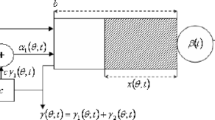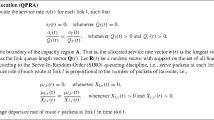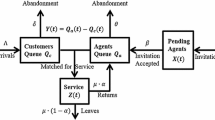Abstract
At the access to networks, in contrast to the core, distances and feedback delays, as well as link capacities are small, which has network engineering implications that are investigated in this paper. We consider a single point in the access network which multiplexes several bursty users. The users adapt their sending rates based on feedback from the access multiplexer. Important parameters are the user's peak transmission rate p, which is the access line speed, the user's guaranteed minimum rate r, and the bound ε on the fraction of lost data. Two feedback schemes are proposed. In both schemes the users are allowed to send at rate p if the system is relatively lightly loaded, at rate r during periods of congestion, and at a rate between r and p, in an intermediate region. For both feedback schemes we present an exact analysis, under the assumption that the users' file sizes and think times have exponential distributions. We use our techniques to design the schemes jointly with admission control, i.e., the selection of the number of admissible users, to maximize throughput for given p, r and ε. Next we consider the case in which the number of users is large. Under a specific scaling, we derive explicit large deviations asymptotics for both models. We discuss the extension to general distributions of user data and think times.
Similar content being viewed by others
References
I. Adan, E. van Doorn, J. Resing and W. Scheinhardt, Analysis of a single-server queue interacting with a fluid reservoir, Queueing Systems 29 (1998) 313–336.
D. Anick, D. Mitra and M. Sondhi, Stochastic theory of a data-handling system with multiple sources, Bell System Tech. J. 61 (1982) 1871–1894.
D. Botvich and N. Duffield, Large deviations, the shape of the loss curve and economies of scale in large multiplexers, Queueing Systems 20 (1995) 293–320.
G. Choudhury, D. Lucantoni and W. Whitt, Squeezing the most out of ATM, IEEE Trans. Commun. 44 (1996) 203–217.
J. Cohen, The multiple phase service network with generalized processor sharing, Acta Informatica 12 (1979) 245–284.
C. Courcoubetis and R. Weber, Buffer overflow asymptotics for a buffer handling many traffic sources, J. Appl. Probab. 33 (1996) 886–903.
A. Dembo and O. Zeitouni, Large Deviations Techniques and Applications (Jones and Bartlett, Boston, 1993).
N. Duffield, Conditioned asymptotics for tail probabilities in large multiplexers, Performance Evaluation 31 (1998) 281–300.
A. Elwalid, D. Heyman, T. Lakshman, D. Mitra and A. Weiss, Fundamental bounds and approximations for ATM multiplexers with applications to videoconferencing, IEEE J. Selected Areas Commun. 13 (1995) 1004–1016.
A. Elwalid and D. Mitra, Analysis and design of rate-based congestion control of high-speed networks, I: Stochastic fluid models, access regulation, Queueing Systems 9 (1991) 29–64.
A. Elwalid and D. Mitra, Statistical multiplexing with loss priorities in rate-based congestion control of high-speed networks, IEEE Trans. Commun. 42 (1994) 2989–3002.
R. Gibbens and F.P. Kelly, Resource pricing and the evolution of congestion control, Automatica 35 (1999) 1969–1985.
R. Gibbens and F.P. Kelly, Distributed connection acceptance control for a connectionless network, in: Proceedings ITC 16: Teletraffic Engineering in a Competitive World, eds. P. Key and D. Smith (Elsevier, Amsterdam, 1999) pp. 941–952.
P. Glynn and W. Whitt, Logarithmic asymptotics for steady-state tail probabilities in a single-server queue, J. Appl. Probab. A 31 (1994) 131–156.
R. Howard, Dynamic Probabilistic Systems, Vol. 1 (Wiley, New York, 1971).
F.P. Kelly, Models for a self-managed Internet, Philos. Trans. Roy. Soc. A 358 (2000) 2335–2348.
L. Kosten, Stochastic theory of data-handling systems with groups of multiple sources, in: Performance of Computer-Communication Systems, eds. H. Rudin and W. Bux (Elsevier, Amsterdam, 1984) pp. 321–331.
M. Mandjes, Overflow asymptotics for large communication systems with general Markov fluid sources, Probab. Engrg. Inform. Sci. 10 (1996) 501–518.
M. Mandjes and J.H. Kim, Large deviations for small buffers: an insensitivity result, Queueing Systems 37 (2001) 349–362.
[20] M. Mandjes and A. Ridder, Optimal trajectory to overflow in a queue fed by a large number of sources, Queueing Systems 31 (1999) 137–170.
M. Mandjes and A. Weiss, Sample path large deviations of a multiple time-scale queueing model, submitted.
L. Massoulié and J. Roberts, Arguments in favour of admission control for TCP flows, in: Proceedings ITC 16: Teletraffic Engineering in a Competitive World, eds. P. Key and D. Smith (Elsevier, Amsterdam, 1999) pp. 33–44.
D. Mitra, Stochastic theory of a fluid model of producers and consumers coupled by a buffer, Adv. in Appl. Probab. 20 (1988) 646–676.
R. Pazhyannur and R. Agrawal, Feedback-based flow control of B-ISDN/ATM networks, IEEE J. Selected Areas Commun. 13 (1995) 1252–1266.
K. Ramanan and A. Weiss, Sharing bandwidth in ATM, in: Proc. of Allerton Conference, 1997, pp. 732–740.
J. Roberts, Engineering for quality of service, in: Self-Similar Network Traffic and Performance Evaluation, eds. K. Park and W. Willinger (Wiley-Interscience, New York, 2000).
J. Roberts and S. Oueslati-Boulahia, Quality of service by flow aware networking, Philos. Trans. Roy. Soc. A 358 (2000) 2197–2207.
W. Scheinhardt, Markov-modulated and feedback fluid queues, Ph.D. thesis, University of Twente, the Netherlands (1998); available at Internet http://www.ub.utwente.nl/webdocs/tw/ 1/t0000008.pdf.
W. Scheinhardt, Analysis of feedback fluid queues, in: Proc. 14th ITC-Specialists Seminar on Access Networks and Systems, Girona, Spain, 25–27 April 2001, pp. 215–220.
M. Schwartz, Broadband Integrated Networks (Prentice-Hall, Upper Saddle River, NJ, 1996).
A. Shwartz and A. Weiss, Large Deviations for Performance Analysis, Queues, Communication and Computing (Chapman and Hall, New York, 1995).
A. Simonian and J. Guibert, Large deviations approximation for fluid queues fed by a large number of on/off sources, IEEE J. Selected Areas Commun. 13 (1995) 1017–1027.
A. Weiss, A new technique of analyzing large traffic systems, Adv. in Appl. Probab. 18 (1986) 506– 532.
Author information
Authors and Affiliations
Rights and permissions
About this article
Cite this article
Mandjes, M., Mitra, D. & Scheinhardt, W. Models of Network Access Using Feedback Fluid Queues. Queueing Systems 44, 365–398 (2003). https://doi.org/10.1023/A:1025147422141
Issue Date:
DOI: https://doi.org/10.1023/A:1025147422141




